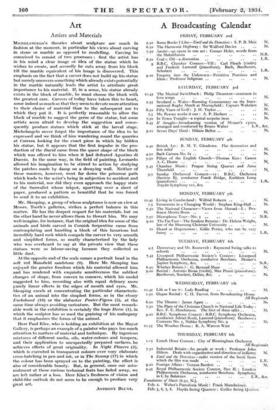Art
Artists and Materials
MICHELANGELO'S theories about sculpture are much in fashion at the moment, in particular his views about carving in stone or marble as opposed to modelling. Carving he conceived to consist of two processes : first the artist has in his mind a clear image or idea of the statue which he wishes to create, and secondly he cuts away from his block till the marble equivalent of his image is discovered. This emphasis on the fact that a carver does not build up his statue but merely uncovers something which already exists potentially in the marble naturally leads the artist to attribute great importance to his material. If, in a sense, his statue already exists in the block of marble, he must choose the block with the greatest care. Carvers of today have taken this to heart, some indeed so much so that they seem to devote more attention to their choice of material than to the subsequent use to which they put it. It is perfectly reasonable to allow the block of marble to suggest the germ of the statue, but some artists seem afraid to develop the suggestion and conse- quently produce statues which stick at the larval stage. Michelangelo never forgot the importance of the idea to be expressed and we think of him wandering round the quarries at Carrara looking for the exact piece in which lay hidden his statue, but it appears that the first impulse in the pro- duction of the David came from the queer shape of the block which was offered to him when it yid defeated Agostino di Duccio. In the same way, in the field of painting, Leonardo allowed his imagination to be stirred to action by studying the patches made by damp on a decaying wall. Neither of these masters, however, went far down the primrose path which leads to the at List's being in subjection to accident and to his material, nor did they even approach the happy state of the Surrealist whose inkpot, upsetting over a sheet of paper, produced a pattern so beautiful that he was forced to send it to an exhibition.
Mr. Skeaping, a group of whose sculptures is now on view at Messrs. Tooth's galleries, strikes a perfect balance in this matter. He has the deepest respect for his materials, but on the other hand he never allows them to thwart him. We may well imagine, for instance, that the original idea for some of the animals and birds carved in Cornish Serpentine came from contemplating and handling a block of this luxurious but incredibly hard rock which compels the carver to very smooth and simplified forms, so neatly characterized by the lady who was overheard to say at the private view that these statues were so labour-saving because they collected so little dust.
At the opposite end of the scale comes a portrait head in the soft red Mansfield sandstone (9). Here Mr. Skeaping has enjoyed the greater freedom which his material allowed him and has rendered with exquisite sensitiveness the subtlest changes of shape, from convex to concave, which his model suggested to him, recording also with equal delicacy more purely linear effects in the edges of mouth and eyes. Mr. Skeaping excels at concentrating the particular characteris- tics of an animal into the simplest forms, as in the ebony Dachshund (19) or the alabaster Pouter-Pigeon (5), at the same time always avoiding caricature. But the most remark- able work in the exhibition is certainly the huge Horse (1), in which the sculptor has so used the graining of his mahogany that it emphasizes the forms of the animal.
Herr Paul Klee, who is holding an exhibition at the Mayor Cutlery, is perhaps an example of a painter who pays too much attention to matters of material and technique. By ingenious mixtures of different media, oils, water-colours and tempera, and their application to unexpectedly prepared surfaces, he achieves effects of great originality. In Night Flamers (5), which is executed in transparent colours over very elaborate cross-hatching in pen and ink, or in The Swamp (17) in which the colour has been sprayed on to the painting, the effect is also of considerable beauty. But, in general, once our asto- nishment at these curious technical feats has faded away, we are left rather at a loss. Herr Klee's freshness of vision and child-like outlook do not seem to be enough to produce very great art.
AN-riloNY Buncr.








































 Previous page
Previous page